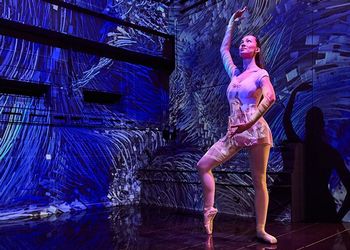Feature: Remembrances of Buildings Past

As MSU nears its sesquicentennial, it's an opportune time to remember once-pivotal buildings that stand no longer.
The MSU campus has been continuously evolving since the first building was erected in 1856. Over the past 144 years, the composition of the campus has been governed by constant change, with new buildings arising, old buildings ceasing to exist, and many buildings renovated, expanded or altered.
Since President McPherson took over more than five years ago, MSU has undergone a Hannahesque construction boom: The DCL building, the Judging Pavilion, the Food Safety and Toxicology Buildling, the Engineering Building addition and the Steve Smith Academic Center for Student Athletes, among others, have dramatically altered the campus skyline. There are currently some 624 buildings on campus, and more are coming. Under construction are the science building and the addition to Agriculture Hall. Under consideration are an equine performance center and a new 1,000-car parking structure.
As MSU approaches its sesquicentennial in 2005, the MSU Alumni Magazine asked University Archives and Historical Collections to provide thumbnail recollections of buildings that no longer stand on campus, but that once upon a time were a vital part of MSU's landscape. Here are six such structures recounted by MSU archivist Jeanine Mazak with Fred Honhart, director of MSU Archives and Historical Collections:
COLLEGE HALL
Built in 1856, College Hall was the first building in America erected for instruction in scientific agriculture. It is believed to have been the first building constructed on campus, with six other buildings following during that year. These buildings were constructed on the site where Beaumont Tower now stands. The hall was built as the school's principal classroom, laboratory and office building. It was the center for all classroom work until 1870.
Unfortunately, the building was poorly constructed and plagued by defects, probably the work of careless or dishonest contractors. College Hall's foundation rested on plank footings, and one corner of the basement wall enclosed a large stump. In 1918, students and alumni, wishing to preserve College Hall as a landmark, sought to rebuild the structure as a student union. After workers found the walls to be hollow, bricks soft and a generally unstable foundation, such plans were dropped.
One August day in 1918, as the National Anthem was being played by the band at a nearby war trainees retreat, the walls of College Hall began to collapse. Members of the football team were used to finish tearing down the building.
PRESIDENT'S HOUSE
Designed by Detroit architect E.E. Myers, the President's House was part of what was then known as 'Faculty Row.' It stood on the present site of Gilchrist Hall. Five University presidents and their families occupied the house between 1874 and 1915. Cowles House, known in the early years as the 'farm cottage,' served as the original President's residence from 1857 until the President's House was built in 1874. In 1915, the President's House was converted into a dormitory for senior women. It also housed the College Hospital from 1925-1939.
From 1939 until it was razed on March 20, 1946, the building was used for a variety of purposes, including a home management practice house for home economics students. In 1941, Cowles House once again became the president's residence when John A. Hannah moved in for good.
ENGINEERING BUILDING
Built in 1907 and in use for only eight years, the Engineering Buildings was of the most prominent building on campus when on Sunday morning, March 5, 1916, fire destroyed the structure and neighboring mechanical shops. Professor Merton M. Cory kicked in the window to his basement office, building ablaze, and with the help of students, salvaged a few thousand dollars worth of mechanical equipment.
Ransom E. Olds preserved the College's engineering program when he donated $100,000 towards the reconstruction efforts after President Frank Kedzie made a personal appeal. The legislature was unwilling to fund a new engineering building and without an engineering facility the program would have faced elimination. The current R.E. Olds Hall, dedicated on June 1, 1917, was erected on the foundation of the former Engineering Building, and was built to similar specifications, which significantly speeded up the time required to build the structure.
QUONSET HUTS
Michigan State College enjoyed a significant increase in enrollment at the conclusion of World War II, in no small part due to the GI Bill®. College housing was inadaquate for this increase in students, so one means to deal with this problem was the purchase of war surplus quonsets, of which 104 were erected On the East side of Harrison Road. Fourteen men slept in bunk beds at one end with a common room at the other end used for studying and recreation. One oversized quonset served as the housing community's cafeteria. (It would later become the home of WKAR Television.) The students were joined by 50 faculty families in 31 quonset homes and 19 pre-fabricated houses.
In March 1950, as Shaw Hall and other new dormitories were finished, students were moved to them from the Quonsets. Eventually married housing and University apartments met the housing needs of married students and families. Many alumni who lived in quonsets remember those 'spartan' facilities with great fondness. Quonset stories and anecdotes are regularly told by those attending the MSU Alumni Association's homecoming brunches, reunion events, and more recently, the Patriarch's Reunion for alumni who graduated at least 50 years ago.
FACULTY ROW
At its height, Faculty Row comprised seven houses. Named so, these homes were built to house early faculty members and their families. Some of the University's first female students were residents of Faculty Row. Construction on the first four brick homes began in 1857. In 1907, East Lansing became a corporate entity as an extension of Faculty Row.
By the 1940s, the growth of the University and its greater community made Faculty Row unnecessary. Demolition of these homes began in 1945 and continued through 1947. Only one structure, Cowles House, was spared. On the site of Faculty Row now stand Landon, Yakeley and Gilchrist Halls.
BAND SHELL
A gift of the Class of 1937, the Band Shell was constructed in 1938. The graduating students raised $2,447.94 towards the building project that cost $25,000 to complete. The structure was used for commencement activities for the classes of 1938 and 1939, as well as numerous outdoor pep rallies and University Concert Band performances. The shell, which had replaced barns around Kedzie Hall, was razed in 1960 to clear land for the construction of Ernst Bessey Hall and adjacent parking ramp.
WELLS HALLS
All three versions of Wells Hall were named for Hezekiah G. Wells, the first President of the State Board of Agriculture. Wells had worked for over a decade to create an agricultural college in Michigan and helped fight off attempts by the University of Michigan to take over Michigan Agricultural College in the school's early years.
The first Wells Hall was built in 1877 as a dormitory that served 130 students. It burned in 1905 and was replaced in 1907 by a larger dormitory structure that was sectioned off into six wards in order to reduce both the hazards of fire and the noise from so many students.
In 1938, the second Wells Hall housed 200 students, a low occupancy rate for the dormitory. During the 1966-1967 academic year, the second Wells Hall structure was razed to make room for an addition to the Main Library.
In 1968, at a cost of $5.4 million, construction started on the present Wells Hall.



